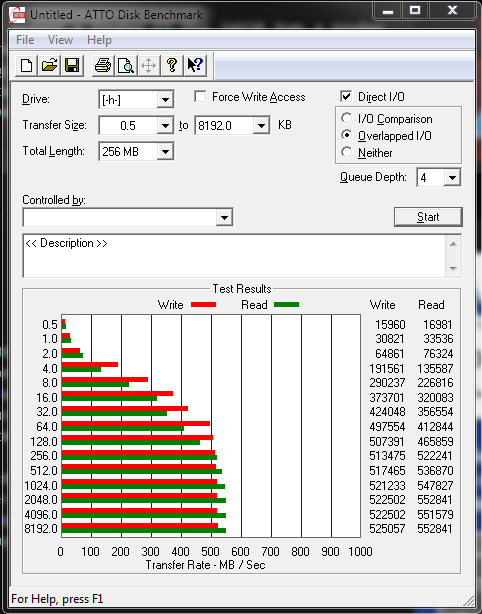ATTO Disk Benchmark is perhaps one of the oldest benchmarks going and is definitely the main staple for manufacturer performance specifications. ATTO uses RAW or compressible data and, for our benchmarks, we use a set length of 256mb and test both the read and write performance of various transfer sizes ranging from 0.5 to 8192kb. Manufacturers prefer this method of testing as it deals with raw (compressible) data rather than random (includes incompressible data) which, although more realistic, results in lower performance results.
Performance results of 552MB/s read and 525MB/s write are in line with manufacturer specifications and typical of ‘LSI SandForce Driven’ SSDs. In fact, some may say that these numbers are an identifying fingerprint of sorts.
CRYSTAL DISK BENCHMARK VER. 3.0 X64
Crystal Disk Benchmark is used to measure read and write performance through sampling of highly compressible data (oFill/1Fill), or random data which is, for the most part, incompressible. We have provided the results of testing in highly compressible data on the left and that of highly incompressible data on the right.

 Our Crystal DiskMark testing was totally unexpected because it is very rare that we see low 4K random write results of over 100MB/s, much less in the testing for both types of data.
Our Crystal DiskMark testing was totally unexpected because it is very rare that we see low 4K random write results of over 100MB/s, much less in the testing for both types of data.
Up until recently, AS SSD was the only benchmark created specifically for SSD testing and it uses incompressible data. AS SSD, for the most part, gives us the ‘worst case scenario’ in SSD transfer speeds because of its use of incompressible data and many enthusiasts like to AS SSD for their needs. Transfer speeds are displayed on the left with IOPS results on the right.

 We see the 4k results have dropped just a bit in AS SSD but they are still very strong. We would like to have seen the overall results and Score higher but these are still great numbers. Although they did not support our CDM results completely, the AS SSD Copy Bench certainly did, with what we believe, may just be the top result for that bench we have seen yet.
We see the 4k results have dropped just a bit in AS SSD but they are still very strong. We would like to have seen the overall results and Score higher but these are still great numbers. Although they did not support our CDM results completely, the AS SSD Copy Bench certainly did, with what we believe, may just be the top result for that bench we have seen yet.
 The SSD Review The Worlds Dedicated SSD Education and Review Resource |
The SSD Review The Worlds Dedicated SSD Education and Review Resource | 

Any reason the OCZ Vector still is missing in the Vantage chart.
Any chance of seeing how the drive does with 25%/50%/75% data on it?
It is a midrange chart displaying only the highest performing SSD for comparison and our site doesn’t fill test in our benchmarks at this point.
Look up on how a SandForce SF-2281 based SSD does over TPU. W1zzard has fill in tests and goes down to %50. [H] does the same at %75. W1zzard’s reviews are more likeable than [H]’s BTW.